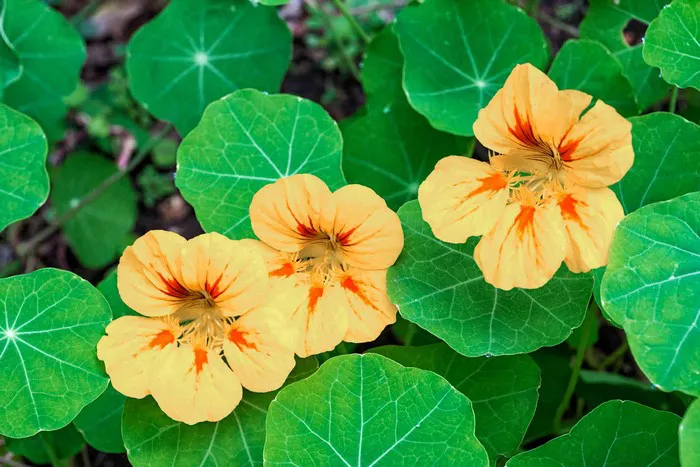Nasturtiums, scientifically known as Tropaeolum majus, are annual flowering plants native to South and Central America. They belong to the Tropaeolaceae family and are renowned for their trailing vines, rounded leaves, and brightly colored flowers. These flowers typically bloom in shades of yellow, orange, red, and sometimes cream, exhibiting a spectrum of colors that captivate gardeners and admirers alike.
Physical Characteristics
Nasturtium flowers possess several distinct physical characteristics that set them apart from other blooms. The flowers are trumpet-shaped, with five petals radiating outward from a central point. These petals often have a slightly ruffled or frilled edge, adding a touch of delicacy to their appearance. The vibrant colors of nasturtium petals are complemented by their foliage, which is characterized by rounded, shield-shaped leaves.
One of the most unique features of nasturtium flowers is their spurred nectar tubes. These elongated structures extend from the base of the flower and contain sweet nectar, attracting pollinators such as bees, butterflies, and hummingbirds. The presence of these nectar tubes not only enhances the visual appeal of the flower but also serves a crucial ecological function in facilitating pollination.
Varieties of Nasturtium Flowers
Nasturtiums come in a variety of cultivars, each with its own distinctive features and characteristics. Some popular varieties include:
1. ‘Alaska Series’: Known for their variegated foliage, with leaves featuring splashes of cream or white alongside the traditional green. Flowers in this series can range from bright yellows to deep oranges and reds.
2. ‘Empress of India’: This variety is prized for its deep crimson flowers and dark green foliage. The contrast between the rich red blooms and the lush green leaves makes ‘Empress of India’ a striking addition to any garden.
3. ‘Whirlybird Series’: Characterized by their semi-double flowers, the ‘Whirlybird’ cultivars produce blooms with multiple layers of petals. This series includes a range of colors, from soft pastels to bold oranges and reds.
4. ‘Jewel Series’: True to their name, the ‘Jewel’ cultivars feature intensely colored flowers in shades of gold, ruby, and bronze. These compact plants are ideal for containers and borders, adding a splash of brilliance to any setting.
5. ‘Tom Thumb Series’: Perfect for small spaces or container gardening, the ‘Tom Thumb’ cultivars are compact and bushy, with petite flowers in a variety of colors. Despite their diminutive size, these plants pack a punch in terms of visual impact.
Cultural Significance
Beyond their ornamental value, nasturtium flowers hold cultural significance in various societies around the world. In some cultures, nasturtiums are associated with symbolism and tradition:
1. In Victorian England: Nasturtium flowers were often used as a symbol of patriotism and conquest, owing to their fiery colors reminiscent of the British flag. They were also considered a symbol of victory and triumph.
2. In South America: Nasturtiums have a long history of culinary use in countries like Peru and Bolivia. The peppery flavor of the leaves and flowers adds a unique zest to salads and other dishes, making them a popular ingredient in traditional cuisine.
3. In Native American cultures: Nasturtiums were valued not only for their beauty but also for their medicinal properties. Various parts of the plant were used in herbal remedies to treat ailments such as respiratory infections and scurvy.
4. In modern times: Nasturtiums continue to be celebrated for their versatility and beauty. They are frequently featured in garden designs, floral arrangements, and culinary creations, serving as a testament to their enduring appeal.
Caring for Nasturtium Flowers
Nasturtiums are relatively low-maintenance plants that thrive in a variety of growing conditions. Here are some tips for caring for these delightful flowers:
1. Sunlight: Nasturtiums prefer full sun but can tolerate partial shade, especially in hotter climates. Aim to provide them with at least six hours of sunlight per day for optimal growth and flowering.
2. Soil: These plants are not overly picky about soil type but prefer well-draining, fertile soil. Avoid over-fertilizing, as this can result in excessive foliage growth at the expense of flowers.
3. Watering: Nasturtiums have moderate water needs and prefer consistently moist soil. Water them deeply whenever the top inch of soil feels dry to the touch, but be careful not to overwater, as this can lead to root rot.
4. Mulching: Applying a layer of organic mulch around the base of nasturtium plants can help conserve moisture and suppress weeds. Mulching also helps regulate soil temperature, promoting healthy root growth.
5. Deadheading: To encourage continuous blooming, remove spent flowers regularly by pinching them off at the base of the stem. This prevents the plant from directing energy into seed production and encourages the development of new blooms.
6. Pest and Disease Control: Nasturtiums are relatively resistant to pests and diseases, but they may occasionally fall prey to aphids, caterpillars, or fungal infections. Monitor plants regularly for signs of damage and treat infestations promptly with organic pest control methods.
7. Support Structures: Depending on the variety, nasturtiums may benefit from support structures such as trellises or stakes to help them climb and sprawl. Providing adequate support not only enhances the aesthetic appeal of the plants but also prevents damage to delicate stems and flowers.
Conclusion
Nasturtium flowers are a delightful addition to any garden, offering a burst of color, texture, and flavor that captivates the senses. With their trumpet-shaped blooms, vibrant hues, and distinctive foliage, nasturtiums are a true feast for the eyes. Whether used as ornamental accents, culinary ingredients, or medicinal remedies, these versatile flowers continue to enchant and inspire people around the world. By understanding their physical characteristics, exploring their diverse varieties, and appreciating their cultural significance, gardeners can fully appreciate the beauty and value of nasturtiums in all their glory.


